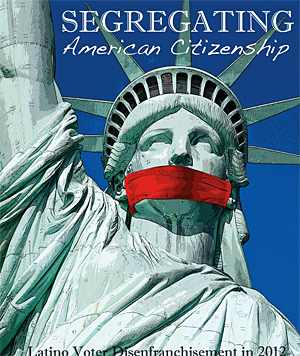| Segregating American Citizenship - Latino Voter Disenfranchisement in 2012 Hispanically Speaking News | |
| go to original September 26, 2012 |
|
 |
The Latino community is a large and integral part of American democracy, comprising more than 10% of the nation’s eligible voters and approximately 8% of its registered voters. Within specific states, those percentages are even higher. In Florida and New Mexico, for example, Latino citizens are more than 26% and 38% of eligible voters, respectively. A number of states have pursued discriminatory voting policies that threaten to undermine the participation of millions of Latino citizens during the 2012 elections.
This report finds that 23 states currently have legal barriers that disproportionately impact voter registration and participation by Latino citizens. These obstacles could deter or prevent more than 10 million Latino citizens from registering and voting in the 2012 elections. In many states, the number of eligible Latino citizens that could be affected by these barriers exceeds the margin of victory of the 2008 presidential election. In Florida, for example, eligible Latino voters amount to nine times the 2008 margin of victory, and in Colorado, the number of eligible Latino voters is twice the 2008 margin of victory. These are among the 23 states that have enacted voter suppression policies impacting Latinos. (SeeTable 4 in Section III, infra.)
The types of voter suppression laws and policies analyzed in this report are:
(1) Alleged noncitizen voter purges of registered voters (in 16 states), which target naturalized citizens and may violate equal protection guarantees. Communities of color, specifically Black, Latino and Asian Americans, form a large percentage of naturalized citizens in states pursuing these purges, with Latinos comprising the largest percentage in most. (See Table 2 in Section II.A.)
(2) Proof of citizenship requirements for voter registration (in effect in Georgia, and pending in Alabama and Arizona), which impose onerous and sometimes expensive documentation requirements on prospective voter registrants. These laws target naturalized citizens, many of whom are Latino. (See Section II.B)
(3) Restrictive photo ID laws in 9 states, which similarly impose costs in time and money for millions of Latino citizens who do not have the required documents. (See Table 4 in Section III)
Voter suppression laws and policies threaten to relegate eligible Latino voters to second-class citizenship and impede their ability to participate fully in American democracy. Like African Americans, Latinos have experienced decreased access and correspondingly lower levels of voter registration and participation than non-Hispanic Whites.
To ensure that access to the ballot box is open and accessible to Latinos as well as all eligible voters, Advancement Project recommends that the unfair policies described in this report be repealed, and that the Department of Justice investigate and prosecute any related voting rights violations.
This report demonstrates that Latino voter participation is much lower than that of non-Hispanic Whites. To address this inequality, we recommend that election officials provide: voter registration and poll worker recruitment at naturalization ceremonies and in high schools; extended early voting periods and evening voting hours for working families; same day voter registration; bilingual materials and assistance at every stage of the voting process; year-round bilingual voter education and outreach efforts; staff designated for Latino outreach; partnerships with Latino civic engagement organizations; and perhaps most importantly, recruitment and retention of more Latino election officials.
See the complete report here at Advancement Project
We invite you to add your charity or supporting organizations' news stories and coming events to PVAngels so we can share them with the world. Do it now!
Celebrate a Healthy Lifestyle
 From activities like hiking, swimming, bike riding and yoga, to restaurants offering healthy menus, Vallarta-Nayarit is the ideal place to continue - or start - your healthy lifestyle routine.
From activities like hiking, swimming, bike riding and yoga, to restaurants offering healthy menus, Vallarta-Nayarit is the ideal place to continue - or start - your healthy lifestyle routine.